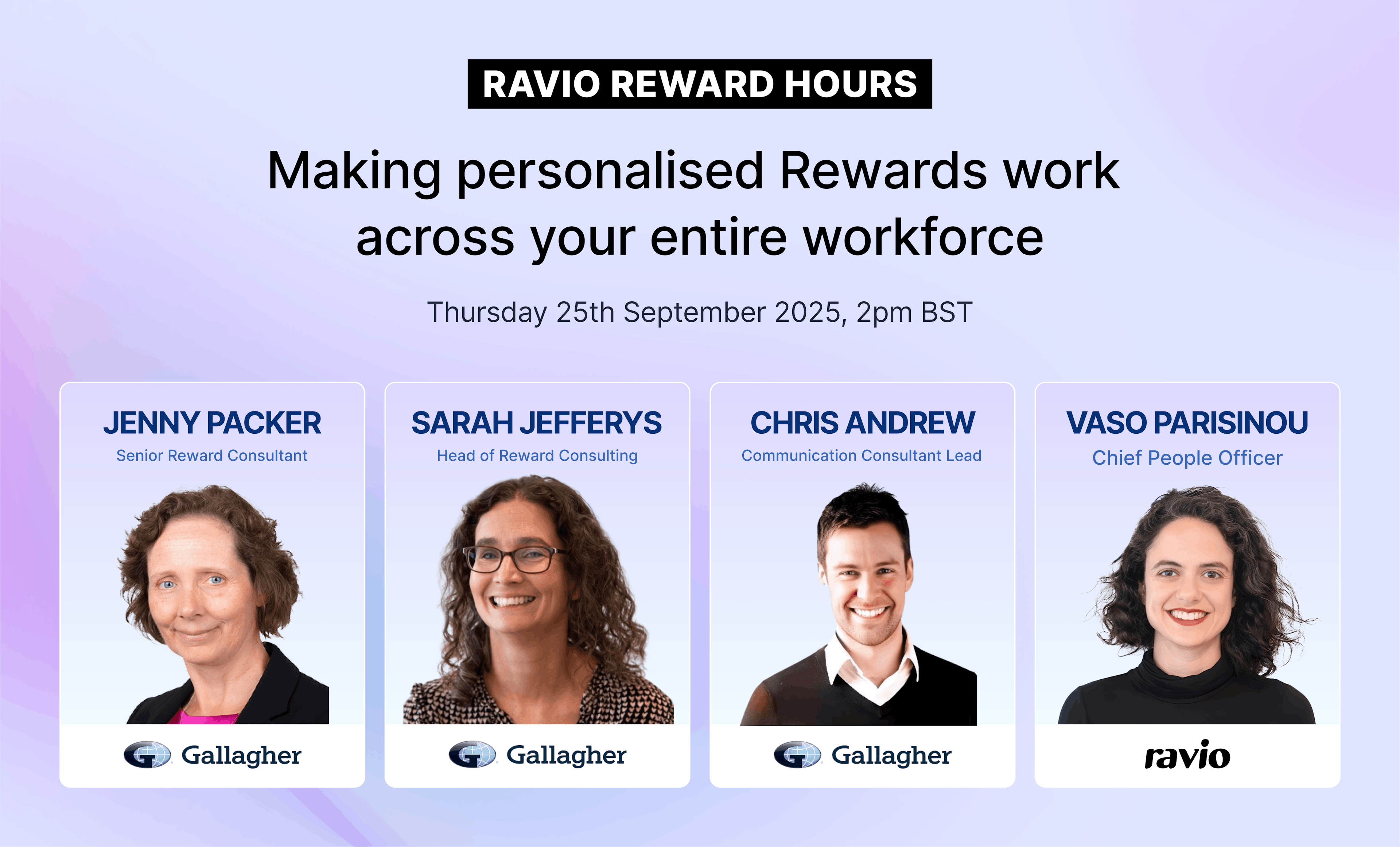The workforce has never been more varied in its preferences, working styles, and location requirements – yet Gallagher’s research shows that 42% of organisations still struggle to create compensation approaches that appeal to this diversity.
From personalised benefits to flexible working in the remote work era, compensation leaders are grappling with how to move beyond a standardised one-size-fits-all Rewards, without losing control of costs and fairness or creating an administrative nightmare.
In our September Reward Community Office Hour, Vaso was joined by Jenny Packer (Senior Rewards Consultant at Gallagher), Sarah Jefferys (Head of Reward Consulting at Gallagher) and Chris Andrew (Communications Consulting Lead at Gallagher) to explore practical approaches to designing personalised compensation.
The discussion drew on insights from Gallagher's 2024 UK Benefits Strategy Report, as well as from Ravio's real-time compensation data, tackling challenges like:
- How to balance core benefits for all with flexible options that truly personalise the employee experience
- Strategies to make operationalising flexible benefits manageable rather than an administrative burdensome
- How company size and culture should influence your personalisation approach – the difference in approach for a 50-person startup vs a 5000-person enterprise
- How can companies use the opportunity to reinforce their EVP through effective communication of benefits
Key takeaways from the webinar
If you're more of a reader than a watcher, here's a few of the most interesting insights from Vaso and the Gallagher team’s discussion on personalised benefits.
Key takeaway 1: Workforce diversity requires data-driven personalisation
For seven consecutive years, the challenge of engaging a diverse workforce has ranked among the top three compensation concerns in Gallagher’s 2024 Workforce Trends Report. With four to five generations working side by side, 23% of employees living with disabilities, 15-20% identifying as neurodivergent, and a rising mix of geographic and cultural backgrounds, there are many complex needs to consider.
Yet many organisations struggle to identify these diverse needs because people don't always self-disclose personal circumstances, and traditional demographic data often misses what truly matters.
💡 Practical application: Move beyond assumptions and surface-level metrics. Use targeted surveys and feedback loops to understand what employees actually value. Then you can design curated benefit choices that strike a balance between personalisation and administrative practicality.
Key takeaway 2: Communication is make or break when it comes to personalised rewards
The biggest barrier when it comes to effective personalisation for rewards is communication.
Gallagher’s research shows 82% of organisations have wellbeing strategies for working parents, however many employees remain unaware of the available support. Benefits carry “assurance value”: even if only a few actively use them, many draw confidence from knowing they exist.
Chris Andrew stated that benefits are "a fundamental enabler of bringing your value proposition to life" but only when employees actually understand what's available and why it matters.
💡 Practical application: Invest in communication strategies that reach different groups through multiple channels. Focus on helping employees understand not just what benefits exist, but why they exist and how to use them effectively.
Key takeaway 3: Flexible working requires intentional design, not just policy creation
90% of organisations now offer hybrid working, making it nearly ubiquitous. However, the recent shift toward return-to-office mandates has highlighted that simply offering flexibility isn't enough – the implementation determines success.
Office time must serve meaningful purposes. There's no point in forcing people spending four hours commuting to an office where they sit on Teams calls all day and don't interact with anybody!
💡 Practical application: Successful flexible working strategies focus on designing in-person time around collaboration and learning, transparently communicating and cultural consistency.



